“In the art of enquiry, the conduct of thought goes along with and continually answers to, the fluxes and flows of the materials with which we work. These materials think in us as we think through them. (Ingold, 2013:6)
Comments: Ingold writes that writing as a practice narrows the gap between thought and expression. Ingold makes the critical point that all knowledge-making is participant observation because the investigator is entangled in the world, learning about it from the inside. Ingold questions whether agency should ever have been extended to humans and sees it much better to think in terms of combined actions and flows, where humans get caught up and swept along.
I am typing and cannot rely on any expressiveness in the lines of my own writing, but hopefully, words can do the trick to express my thoughts. I also rely on my Grammarly App, which recently added AI assistance and I hope it helps my writing.
Developing your enquiry
At the start of this part of the course is an image of work from artist Anne Truitt. The work is called Exterio of barns proclaim their interiors (1965), work done with pen and ink and part of sketchbook entries by the artist. I want to understand the context of this work for the course, and I researched her work. I learned that Truitt was known for her minimalist sculptures and paintings. She also published three journals, including Daybook, Turn, and Prospect, chronicling her approaches to art making, parenthood, memories, and thoughts on life as an artist. Her curiosity and openness captured me in how she shared her life as an artist with readers. I found the three books on SCRIBD to read as on combined e-book. From her drawings, I learned that she was intrigued by lines, edges and colour. She experimented with different media and techniques, like clay, cast cement and plaster, and steel welding. It became clear that relationships between colour and shape became important in her work; it seems that it became metaphors for her thinking about people, place and ideas.
I read a pdf with excerpts from “Philip Guston Talking, a lecture he gave at the University of Minnesota in March 1978 ( SCRIBD). In this talk, the artist brings another perspective which I think correlates to the work of Anne Truitt – ideas of minimalism as painting was being re-considered and that they worked with concrete objects. Still, they discovered ‘freedom’ to do whatever they could imagine. They kept their drawing practice ongoing and explorative before painting/sculpting/making.
I need to ask questions about my making as well. Looking at where I am with my studies of Research, I have now sought out material related to my area of interest in Part One and Part Two, where I took stock of the material and started to analyse my thinking of building arguments and how I will gather material. I am very aware after my tutorial of the importance of coming up with a set of research questions to which my project will seek answers – it will help me plan and continue to focus my research.
My research questions will compare and argue that the Ubuntu principles and New materialist ideas of the agency of non-human is evident in my work and how I create in my practice. I will also examine how this idea emphasises our human relationship with Earth and Nature.
Exercise 1.1: Sorting and Categorising
Wisdom is taken from a quote by David Hockney: “I ask such questions and make the theories only afterwards, not before – only after I have done something (1993, p 130)
Looking at how I research in my practice can I state that my position is practice (informed) based and that the lived experience, my making and reflecting after it is made, is part of how I make and search for knowledge around my ideas? I came upon an article by Graeme Sullivan, Research Acts in Art Practice (2006), where he argues that art practice is a creative and critical form of human engagement that can be conceptualized as research. He argued that ideas of possibility and curiosity must be explored to reach knowledge. This is not a linear procedure but interactive and reflexive. “Imaginative insight is constructed from creative and critical practice. ” Later in the article, the idea of research being a ‘transformative act’ was discussed, and the importance of complementary pathways to create new knowledge is at the heart.
Sullivan refers to Rita Irwin, a Canadian researcher, who has developed a research approach, called “A/r/tography”, which references the multiple roles of the artist when the art practice is explored as a site for inquiry. This means the artist becomes someone who en-acts and embodies creative and critical questions. It would be good for research purposes if I could understand more about what happens before the work is produced – thoughts and influences. This confirms why I decided to call my different work processes ‘para-sites’. In my opinion, there lies information and knowledge (?) around what happens before art is produced – the processes will be shown and discussed/reflected upon. I do not want my making to be seen as theory-dependent; I would like it to be considered mindful, intuitive and discoverable.
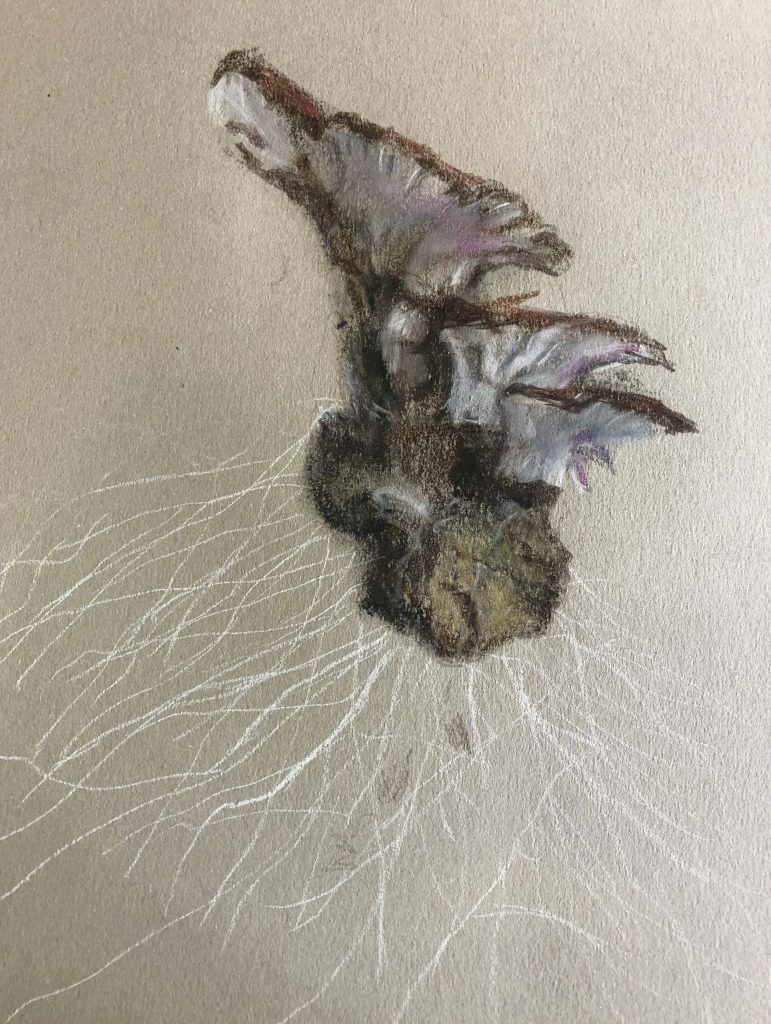
A bracket fungus begins its life as a spore, one of hundreds of thousands produced by a mature fungus. If the spore lands on a favourable location, such as a tree stump, it sprouts thin thread-like mycelium. Mycelium cells manufacture and secrete enzymes that digest the wood. The tree’s cellulose is broken down into simple sugar building blocks, which the fungus absorbs.
Headings under which I can sort and divide my research material
Contextual Information and Key Topics
In looking at the Carrier Bag Theory of Fiction, ( Le Guin), I find ideas to maintain, contain and receive rather than kill and control can be applied with these ethics of care and empathy within relationships with non-humans and exploring art making. I also consider my work as a form of storytelling about my interactions with the natural world and how it heals and maintains me. I acknowledge that her writing is about imagining, but her theory is practical to help us live (dream about, envision) better. I learn from this feminist approach that storytelling is a way of configuring and reconfiguring worlds; narratives can bring realities into being.
In my copy of this book is an introduction by Donna Haraway, called, Receiving Three Mochilas in Colombia: Carrier Bags for Staying with the Trouble Together. Haraway is convinced we need to “tell the ‘other’ story, the untold one, the life story ” (1988: 10). She suggests using stories intentionally to tell other stories. She described three different carrier bags she received after a visit to Columbia, and that she needed them for collecting powerful things to nurture and that to carry or wear any of these bags is a way to enter into the knotting’ of capacities to respond and ‘become with’ (1988:12) There are also visual images of these bags. She shared research findings of work done in the Philipines amongst the Agta group, which can be seen as modern-day hunter-gatherers. I was reported that the responders value storytellers over all other kinds of people – they want to hear and listen to stories and that these stories create empathy and openness to welcome even strangers into their midst. This reminds me of research – that it should have meaningful information to be shared.
Later, in Staying with the Trouble, Harroway writes: “It matters what thoughts think thoughts. It matters what knowledge knows knowledge. It matters what relations relate to relations. It matters what worlds world worlds. It matters what stories tell stories” (2016, 35), and note that Le Guin influenced her (2016,39). Anna Tsing in The Mushroom at the End of the World also refers to Le Guin when she writes:” In this kind of storytelling, stories should never end, but rather lead to further stories” (2015, 287). She closes her book with a lengthy quote from The Carrier Bag Theory. Tsing has convinced me that human beings are products of and depend on collaboration and contamination for our survival and evolution, and, like matsutake mushrooms and other species, we are living in and adapting to damaged environments.
The Ubuntu idea: “I am because we are”, emphasizes that humans are fundamentally connected with the world around them and each other. Latour talks about the ‘actor-network theory’ and argues that humans and non-human entities are interconnected in complex networks, where each actor plays a role in shaping the world. This brings me to recognise the agency of non-humans in my work and the overall well-being of animals, plants and the environment/nature. I find that dualistic thinking is challenged in both Ubuntu’s and Latour’s ideas. Ubuntu views humans as inseparable from their fellow human beings and their environment, while Latour highlights the agency and influence of non-humans on human life/affairs. Both perspectives encourage a respectful and inclusive approach to non-human life. I am uncomfortable scoring species according to their importance and viewing humans as the crown of creation.
Ubuntu has an underlying ethic of care and empathy, emphasising communal relationships. It also extends towards a shared responsibility towards the Earth and its well-being. Ideas of adapting to the environment ring true for me. I prefer to place species alongside each other and see these ideas historically strongly influenced by politics, culture, history and religion.
Looking at research methodologies, I would like to work around a contextual study or essay. Research methods would be learning from cultural anthropology and ethnography, being a bricoleur with a multi-method approach and a reflective practice, primarily based on made work ( called my para-sites) to test assumptions and or solutions to problems. Theoretical perspectives will be based on Posthumanist. I will use ideas of Deleuze, Latour, Harroway, N Mayers and Bennet, mainly concerned with agency and interconnectivity between the human and non-human.
Care and Maintenance
Here I consider time and care to make work, to document and archive it.
Collaborative work with a cohort group
Explore the effect of this on my ideas of inter-dependency and working with the non-human, but also opening up to other ideas and learning from other artists or disciplines and how I apply this knowledge in my making. I will consider artists whose work will inspire my thinking and making.
Making
I have implemented ( learned from Research-Creation in the book Knowings and Knots) to work on different ‘para-sites’. I will continue exploring these ideas in my research together with an experimental making process. I am also considering exploring ideas of the Japanese Gutai Art movement, as it implies a physical embodiment of an idea where materials and actions/making were equally important. There is an importance placed on the performance and recording of activities that produced the work.
Sporeprints and developing it as a work that could continue to grow in the soil as time-based installation art. The current work includes mycelium drawings, paintings, and sculptures. Making 3d nest-making as a showing of the process of making with natural fibres and mixed media refer to gestures of tying, coiling, twisting, knotting and wrapping, which can give rise to a new form., and talk about how things join or interact. I like to think of how Ingold talks about a line as how we frame our lives as social beings. (The Life of Lines, Time Ingold, 2015) In this way, my work talks about something that has passed, a vestige or fragment and how this relates to the physical and personal environment ( my reaction).
This made me think about the relationship between humanity and natural phenomena and how we experience this. My work with mushrooms, nests, and feathers shows formal compositions where a series of works have been developed, and some work can be seen as time-based. I think within the spores; I have learned something about predictability – the colour of spores and patterns are predictable between species. I am asking viewers to look closely beneath the surface to that which is hidden chiefly and explore that as an experience around a relationship with the non-human world. (mycelium) I like to think that this work challenged me in how I look or see things to become aware of appearances and things that are hidden (underground like mycelium) and question imitation within my work by exploring ideas in more than one medium and opening up more possibilities of making.
Making sporeprints with mushrooms made me aware of how we all leave traces and physical marks as we move. Our connectedness with nature is also locked up in these marks.
I regularly start a daily practice of drawing one object over a limited time and see it as a provocation to work or develop new work. I have been drawing a type of bracket mushroom I found on a walk a few months earlier. Interestingly, I mainly worked with ink, soft pastels, charcoal and aquarelle pencils.
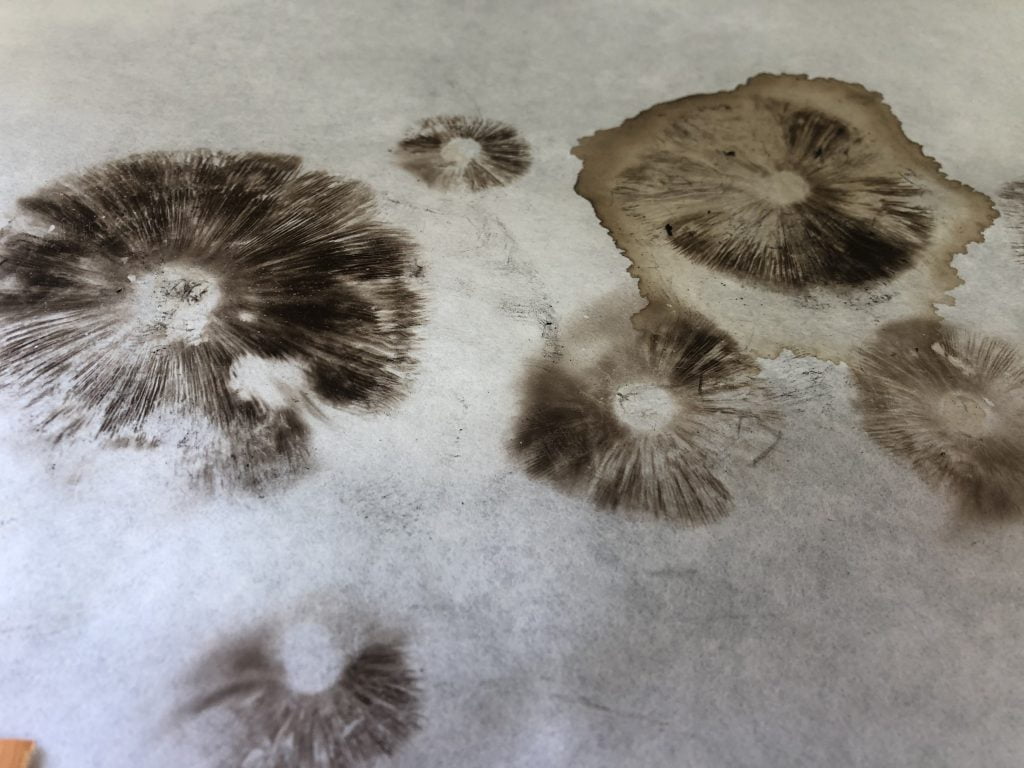
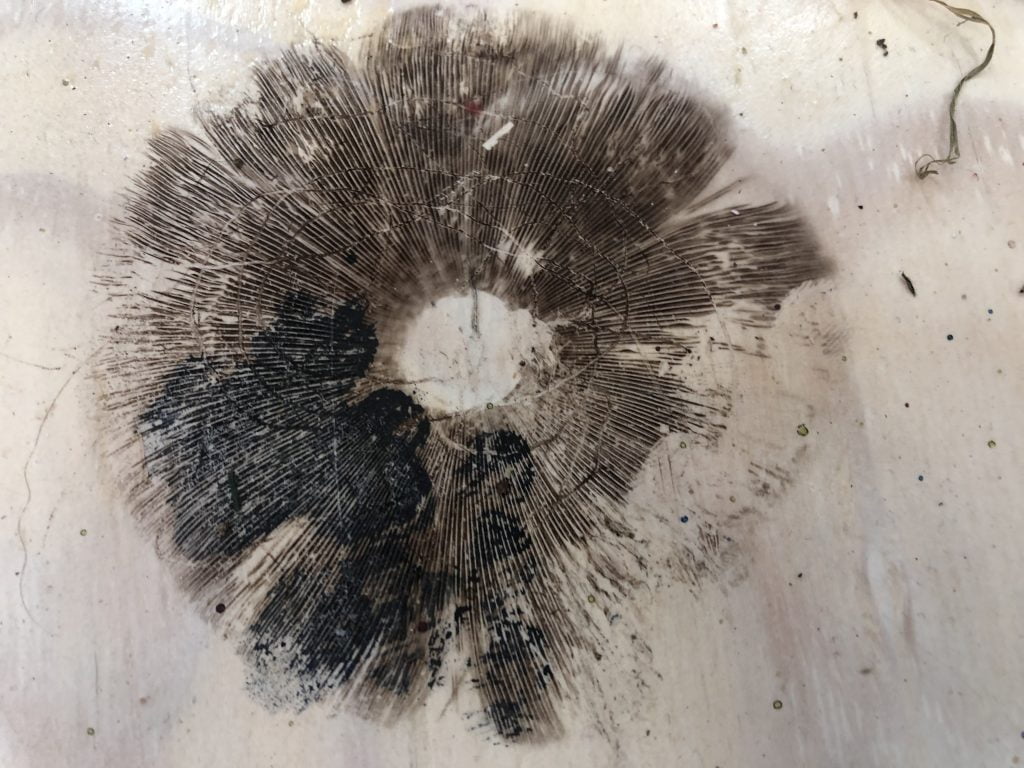
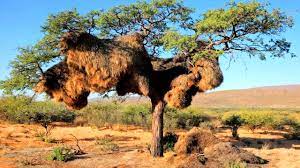
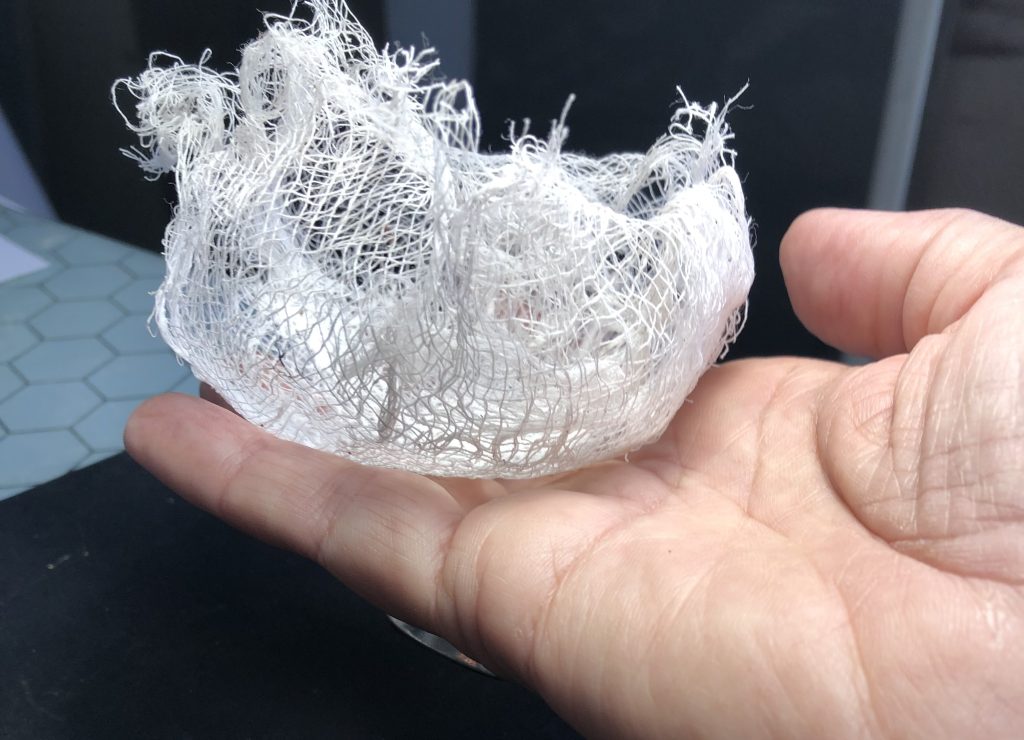
Cultural/Pollitical information
Ubuntu and Agency of the non-human and collaborating with. A Tsing around capitalist and ‘western’ ideas of ecology. Look at other authors: Peter Wohlleben, Robin W Kimmerer and Merlin Sheldrake
Contemporary artists
Look at work which shows working with nature as a material, who look at the development of a subject/object.
Earlier in the course, my tutor suggested I look at the work of Dove Bradshaw, Contingency Paintings, the alchemy in these works stays intriguing, and I want to explore her working process alongside my own making as part of the experimentation with natural materials and the chemistry that could happen in the making. It seems that her work takes Pollock’s drip painting technique to the next level; the liver of sulfur, with which she works, makes marks on the silver and continues to interact. I like the agency coming to play in this process. ( a separate blog post was written to research her work)
Ana Mendieta (separate blog post was written)
William Kentridge – works like Procession where he uses video and mixed media such as collage, charcoal and paint on canvas.
References and Key Topics
I have been reading Peter Wohlleben (The Hidden Life of Trees, The Heartbeat of Trees is on my to-read list), Emanuele Coccia (The Life of Plants) and Merlin Sheldrake (Entangled Life), and Robin W Kimmerer (Braiding Sweetgrass), which greatly influenced my thinking around my interactions and interest in nature. In my recent studies, I also discovered work by Goethe and Rudolf Steiner to enforce my ideas. Integrating concepts of the Carrier Bag Theory of Fiction of U Le Guin in my making around nests made me more aware of how aggression, being the fittest and male power, filtered into science, religion, politics and culture and talks about female presence to explore.
Exercise 1.2 Exploring and Uncovering
A feminist approach could support my arguments about care/concern/empathy/ as well as ideas of Ubuntu. In many ways, I am looking at my material and making it from a subjective view, and I need to use research in my argument to bring a more subjective perspective into the work. It was good to focus on the case study in the study material.
Reflection on the Case study in the study material
Tom McCarthy’s statement seems to allude to the complex interplay between objectivity and subjectivity when researching art, especially when the physical object becomes a focal point. It suggests that researchers must be conscious of how the materiality of an artwork and the research materials they choose can influence their analysis and findings. It seems that striking a balance between the two can lead to a more nuanced and comprehensive understanding of the subject matter, whether it’s an artwork’s materiality or the findings of a research study. It is a great reminder to be aware of my biases and strive to maintain objectivity while acknowledging that complete objectivity may not always be achievable.
EXERCISE 1.3: REVISIT, REFINE
Have I uncovered all the links and relationships between my studio work and research in this course? Such a huge question!
I started returning to my tutorial sessions and notes and comparing them with my work process.
I revisited work by Natasha Myers around a project she calls Rooting into the Planthroposcene. It talks to my reading of Le Guin’s Carrier Bag Theory as it is also about stories we must tell. I like the term “to conspire with plants” when she shares the ten steps of this incantation. She invites the reader to experiment with ways of dreaming life differently. I feel it also connects to ideas of Tsing when she writes about damaged landscapes:
Incantation (2021).
Step 1. Never forget this: “we'”are not “one”
Step 2. Break this world to make other worlds possible
Step 3. Repeat this mantra: we are not alone, we are not alone, we are not alone….
Step 4. Name our most powerful ally
Step 5. Foment plant/people conspiracies to root into the planthroposcene
Step 6. Disrupt colonial common sense
Step 7. Vegetalise your sensorium
Step 8. Take ecology off the grid
Step 9. Garden against Eden
Step 10. Make art for the Planthroposcene
I also feel it is essential to include my collaborative explorations. I find these great learning opportunities where I engage in the broader pool of experience and learn to share (give and take) in a safe environment. By not being physically in contact with the group members, I find chats enable constructive discussions and become more inclusive. We have a once-a-month Zoom meeting, but with a broader group (OCA EU), new opinions and ideas develop as members share from different cohorts.
List of Illustrations
Fig. 1 Stander, K. (2023) Fungus: Daily drawing [Photograph of pastel drawing in sketchbook] In possession of: the author: Langvlei Farm, Riebeek West.
Fig. 2 Stander, K. (2023) Fungus: Spore print [Photograph] In possession of: the author: Langvlei Farm, Riebeek West.
Fig. 3 Stander, K. (2023) Spore print [Photograph of spore print on the studio floor] In possession of: the author: Langvlei Farm, Riebeek West.
Fig. 4 Whiting, Maartin, J. (2014) At Home with the Birds [Photograph] At:researchgate.net/figure/Sociable-weaver-Philetairus-socius-nest-in-the-Tswalu-Kalahari-South-Africa_fig5_262308578 (Accessed 15/05/2023).
Fig. 5 Stander, K. (2023) Gauze container [Photograph] In possession of: the author: Langvlei Farm, Riebeeck West.
Bibliography
Haraway, Donna. J. (2016) Staying with the Trouble Duke University Press downloaded as pdf . At: SCRIBD (Accessed May 2023)
Le Guin, U. (1988). The Carrier Bag Theory of Fiction. Published by Ignota. downloaded as pdf. At: SCRIBD (Accessed January 2023)
Sullivan, Graeme. (2006) Research Acts in Art Practice Published in A Journal of Issues and Research, 2006. At: https://aboutjstor.ort/terms. ( Accessed 25/07 2023).
Tsing, A. (2015) Mushroom at the End of the World . Read online. At: SCRIBD. (Accessed 14/06/20230.
What’s in your bag, Ursula K. Le Guin?